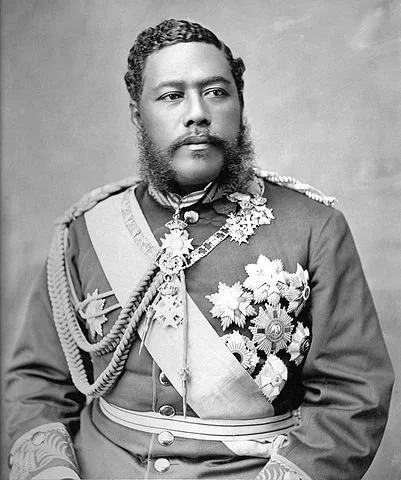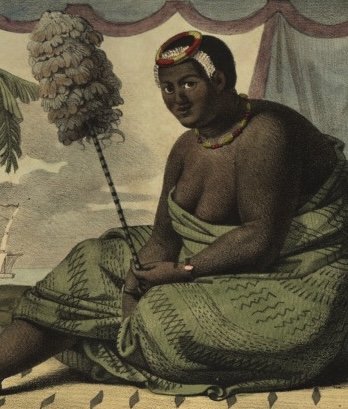Admission Day Ceremony of the Territory of Hawaii held on June 14, 1900. Author Unknown. Bernice P. Bishop Museum. https://commons.wikimedia.org/wiki/File:Hawaii_Territory_Admission_Day_Ceremonies.jpg
Most of the wealthiest sugar planters were not dedicated annexationists, primarily because they feared being joined with the United States would put an end to importing Asian contract laborers, a cost saving measure that was necessary to make the sugar industry as profitable as it was. Nor were most of them supportive of enfranchising Asian workers or Native Hawaiians. The most militant annexationists tended to be lawyers and businessmen with some investments in various sugar plantations. The wealthier planters could afford to sit on the fence between the Hawaiian monarchy and the Annexationists.
The largest corporations which came to be known as the Big Five, were C. Brewer, Castle & Cooke, Alexander and Baldwin, Theo. Davies & Co., and Hackfeld & Co., which later became American Factors. These companies owned multiple plantations, as well as the companies that supplied them, the refineries and factories that processed and sold the sugar for them, as well as the banks that made it all possible.
They imported indentured servants and other coerced laborers in large groups by contract, first with Chinese, then Japanese and Portuguese, and then Filipino workers. Multiple anti-Asian laws of both Hawaiian and American origin prevented many of these people from naturalizing and earning citizenship. It would take these groups many decades to effectively organize for political rights.
The Big Five wanted to be wealthy and powerful enough to control or strongly influence politics, without being responsible for politicking. They wanted to provide jobs that made the majority of workers dependent on them without the responsibility of adhering to the prevailing labor laws of the day in their home countries. They poured money into schools for non-Whites but also supported stipulations that banned Hawaiian language and culture, and required a particular American ideology that institutionalized White supremacy and classism.
The grassroots political organizations created by Native Hawaiians, the Hui Kālai ‘āina, and the Hui Aloha ‘Āina both vigorously protested American annexation. They both delivered petitions signed by a majority of the Native population. Queen Lili’uokalani also submitted a formal protest to the annexation and appropriation of her crown lands. Regardless of their clearly communicated legitimate claims or their allies in the US and around the globe, the McKinley administration pushed annexation through in the midst of the Spanish/American War. The majority of Americans and Europeans saw the Native Hawaiians, and Polynesians generally, the same way they saw all the indigenous peoples of the Americas, as “vanishing races” whose populations were rapidly decreasing and could be disregarded politically and socially. This prevalent racist worldview, combined with the strategic benefit of the Hawaiian islands’ location in the Pacific for a fledgeling empire made American politicians confident in seizing control of the kingdom along with the Philippines and other islands.
Seal of the Territory of Hawaii. Translation:
“The Life of the Land is Perpetuated in Righteousness.”
Following the formal annexation, all the laws of the illegally established Republic of Hawaii were left in place until Congress could establish a territorial government for the islands. Dole and Thurston were hard at work advocating for terms that would retain the privileged position of wealthy Whites and keep Asian laborers and Native Hawaiians politically sidelined. Robert Wilcox played a pivotal role in lobbying Congress to remove property requirements from voting rights, the main tactic that had kept Native Hawaiians from voting in their own country. He also worked to establish an Independent Home Rule Party that would challenge White rule in the legislature. Hawaiian language newspapers were already numerous, but they rapidly increased in number as a tactic for preserving Hawaiian language, culture, history and bolstering an indigenous nationalism in resistance to American hegemony. As a territory, Hawaii elected a non-voting delegate to the US Congress to represent them. Robert Wilcox was among the first to be elected to this post.
Sources:
Hawai’i’s Territorial Period in Context- University of Hawai’i
History of Labor in Hawai’i- University of Hawai’i
Kihei Soli Niheu plays Robert Kalanihiapo Wilcox, Jan. 1993- Hawaiian Voice
Katrina-Ann, R. “The Hawaiian Language Revitalization Movement.” In A Nation Rising: Hawaiian Movements for Life, Land, and Sovereignty, edited by Goodyear-Kaopua, Noelani, Ikaika Hussey, and Erin Kahunawaika’ala Wright, 78-85. Duke University Press, 2024. https://books.google.com/books?hl=en&lr=&id=m9LZBAAAQBAJ&oi=fnd&pg=PA26&dq=the+hawaiian+language+revitalization+movement+katrina-ann+r.&ots=yQzWC3dTuL&sig=XRtAkbjsBf99WICpEYyEP6eO8cw.
Silva, Noenoe K. “I Kū Mau Mau: How Kānaka Maoli Tried to Sustain National Identity within the United States Political System.” American Studies 45, no. 3 (2004): 9–31.
———. “Joseph Moku’ōhai Poepoe.” In The Power of the Steel-Tipped Pen: Reconstructing Native Hawaiian Intellectual History. 105-149. Duke University Press, 2017. https://books.google.com/books?hl=en&lr=&id=L8LADgAAQBAJ&oi=fnd&pg=PT8&dq=Reconstructing+Native+Hawaiian+Intellectual+history:+joseph+mokuohai+poepoe&ots=1_dfQm4DtZ&sig=IVwOiUOJpgOMRcxTqDVOjMpN6WA.
Whitehead, John S. “Western Progressives, Old South Planters, or Colonial Oppressors: The Enigma of Hawaii’s ‘Big Five,’ 1898–1940.” Western Historical Quarterly 30, no. 3 (1999): 295–326.
















